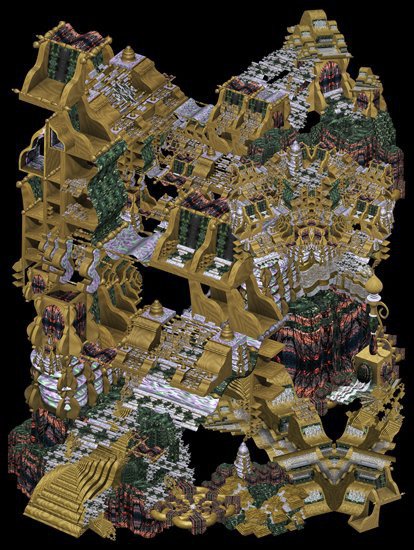Stone Sky Over Thingworld
dal 1/6/2011 al 28/7/2011
Segnalato da
1/6/2011
Stone Sky Over Thingworld
Bitforms Gallery, New York
The artists, Michelle Ceja, Brenna Murphy, Jon Rafman and Artie Vierkant, are part of a young, international group working with technology that have developed a related practices.

Curatorial Statement by Claudia Hart, School of the Art Institute of Chicago. March 20, 2011
My original idea for entitling this show was When Androids Dream, after the story by Phillip K. Dick and the source for the sci-fi noir classic Blade Runner. This was because, and to quote Wikipedia (somehow appropriate to quote it in reference to Dick), he “explored sociological, political and metaphysical themes in novels dominated by monopolistic corporations, authoritarian governments and altered states,” as did all of the young artists I invited to participate in the exhibition. They countered with their own Stone Sky Over Thingworld, which I actually prefer. To me, their title is less dark, yet still suggests a surreal world turned upside down, where things are preferred over humans. It reminds me of Magritte, and is not un-Dickian.
The artists, Michelle Ceja, Brenna Murphy, Jon Rafman and Artie Vierkant, are part of a young, international group working with technology that have developed a related practices. The relatedness of their style and discourse emerges from several factors, significantly their educations, the function of the Internet as a system of distribution and communication, - and ultimately, their shared attitudes and digital strategies.
As digital media has become more widely available in art schools, young artists educated in contemporary practice and discourse are able embrace high-end technologies previously only available in an engineering context. This means that the interests and practices of a young group emerge directly from recent contemporary art, and are therefore critical in their orientation- more so than that of the first generation of media artists. Contemporary art, particularly the style of art making practiced at humanities-oriented art schools in the U.S., adopt a materialist and often Marxist critique of the media as their theoretical tactic. This is very different from the digital media artists of the Ars Electronica generation - those supported by the new media festivals and institutions positioned as hybrids between digital design, computer science and art, more Utopian in their embrace of the new.
In addition, this is a young generation that lives virtually - on the Internet - having grown up online, fully engaged in its social networking systems. The Internet, for them, is not just a means of communication but also a system of distribution for digital art. In recent years, they have proliferated Tumblr system web galleries, as well as online virtual spaces like the Berlin-based Chrystal Gallery, intended as artificial spaces for simulated art. As a result, young artists with strongly related styles have emerged in Berlin, in Chicago, in Los Angeles, Baltimore, New York, and Montreal, all connected to art schools that are humanities and contemporary-art oriented. In addition, because ideas of democratization are an essential part of Internet culture, they artists seem free to exchange themes, iconography and stylistic elements, creating an astonishingly strong inter-relatedness across an international geography.
As a result of these situations, certain distinctive iconography and themes are also shared: Sci-fi - including lots of manifesto writing, with a strong Dystopian futurist bent; Pop Art - taking the form of a pseudo advertising landscape employing the tropes of Internet ads and peopled by what is apparently a breed of Cyborgian advertising clones; and Sacred Geometry - a view of the mathematical nature of digital art that is symbolic and metaphoric, reminiscent of the Surrealism of Magritte rather than the mathematical formalism embraced by the Ars Electronica generation. The result is a return to classicism and figuration, also connected to the minimalist and classicistic aesthetic style adopted by the advertising industry to brand high-tech products as somehow “enlightened.” All off these qualities are emergent, but open to myriad possibilities. It is with extreme interest that I follow their work.
Opening Reception: Thursday, June 2, 6:00 – 8:30 PM
Bitforms gallery nyc
529 West 20th St, New York NY 10011
Hours: Tue–Sat, 11 AM–6 PM



